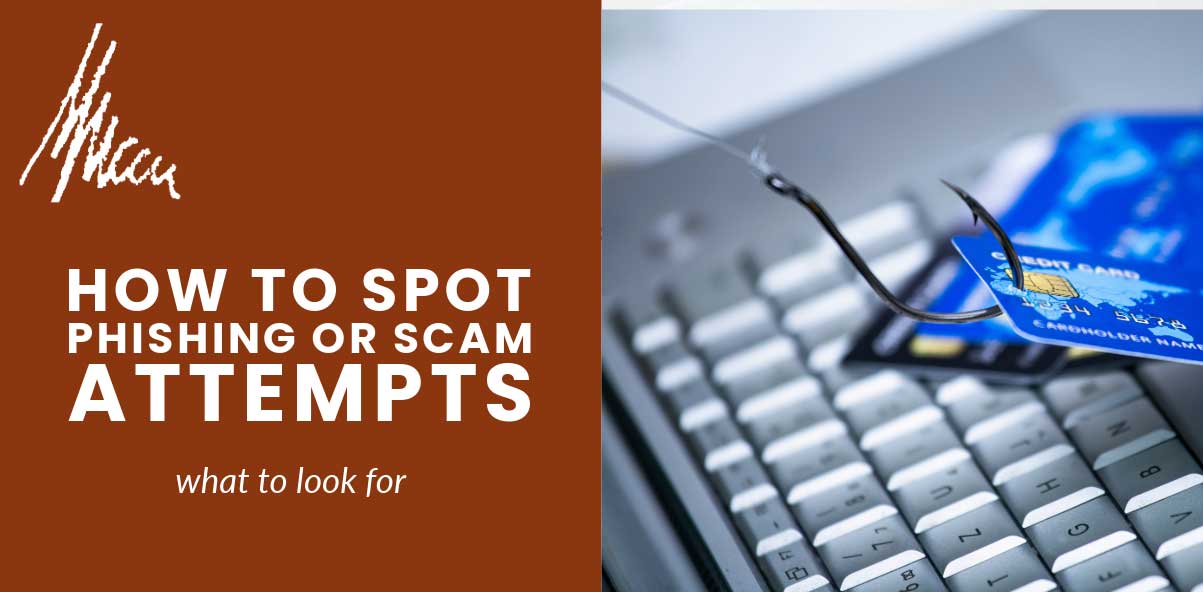How to Recognize Legitimate Communications vs. Phishing or Scam Attempts
It’s important to remain vigilant against phishing and scam attempts. These fraudulent activities often imitate legitimate organizations, deceiving even the most cautious individuals. To help you protect yourself and your sensitive information, here’s a guide on how to recognize legitimate communications from phishing or scam attempts. Also, be sure to check out our page on Security & ID Theft Awareness.
1. Check the Source of the Communication
Legitimate communications from reputable organizations will always come from official channels. Whether it’s an email, text message, or phone call, always verify the source:
- Email: Official emails will always come from a trusted domain. Be wary of slight misspellings in the email domain (e.g., “@organization.com” vs. “@organizatoin.com”)—scammers often use these tricks.
- Text Messages and Phone Calls: Legitimate organizations will never ask for sensitive information (such as your PIN or account number) over text or phone. If in doubt, hang up and call the official number to verify.
2. Look for Suspicious Links or Attachments
Phishing emails and text messages often contain links or attachments that, when clicked or downloaded, can compromise your information or infect your device with malware. Before clicking on any link or downloading any attachment:
- Hover over links: Move your cursor over the link to see the URL. Legitimate links will match the official website of the organization. If the link looks suspicious or doesn’t match the website you trust, it’s a red flag.
- Attachments: Be cautious with attachments from unknown senders or emails urging you to open them quickly. Legitimate organizations will never ask you to open attachments unless you’ve requested them.
3. Assess the Tone and Language
Legitimate communications typically maintain a professional tone, while scammers often use urgent or threatening language to force quick action. If an email or text message sounds too good to be true (e.g., claiming you’ve won something or threatening account suspension), it’s likely a scam. Other warning signs include:
- Poor Grammar or Spelling: Scammers often fail to pay attention to detail. Look for typos, awkward phrasing, or inconsistent formatting.
- Urgency or Threats: Scammers try to create a false sense of urgency, such as stating your account will be locked unless you act immediately. Legitimate organizations will not pressure you to act without providing sufficient time for consideration.
4. Verify Requests for Personal or Financial Information
Legitimate organizations will never ask for sensitive personal or financial information (such as your PIN, password, or account number) through unsolicited emails, text messages, or phone calls. If you receive such a request:
- Do not respond: Contact the organization directly using the contact details from their official website to verify if the request is legitimate.
- Never share sensitive information: Reputable organizations will never ask for personal or financial details through unsecure communication methods like email or phone calls.
5. Check for Consistency Across Channels
Scammers often imitate the look and feel of official communications. To ensure that the message you received is legitimate, check for consistency across different channels:
- If you receive an email, verify the details through your account or the official app of the organization.
- If you receive a phone call, call the official number to verify the inquiry.
6. Use Multi-Factor Authentication (MFA)
Many organizations now encourage the use of Multi-Factor Authentication (MFA) for an added layer of security when accessing accounts. MFA requires you to verify your identity through a secondary method (such as a code sent to your mobile device). Even if a scammer acquires your login credentials, this extra step can prevent unauthorized access to your accounts.
7. Report Suspicious Communications
If you suspect that you’ve received a phishing or scam attempt, report it to the relevant organization immediately. They can help identify fraudulent activity and protect your accounts. Reporting scams can also help prevent others from becoming victims of similar attempts.
Recognizing phishing and scam attempts is key to protecting your personal and financial information. Stay vigilant and always verify communications that seem suspicious. If something doesn’t feel right, trust your instincts and take the necessary steps to ensure your security.
If you have any questions or need assistance, don’t hesitate to contact the organization directly. As always, MMCCU is here to help! If you have any questions about a communication from MMCCU, please reach out!

